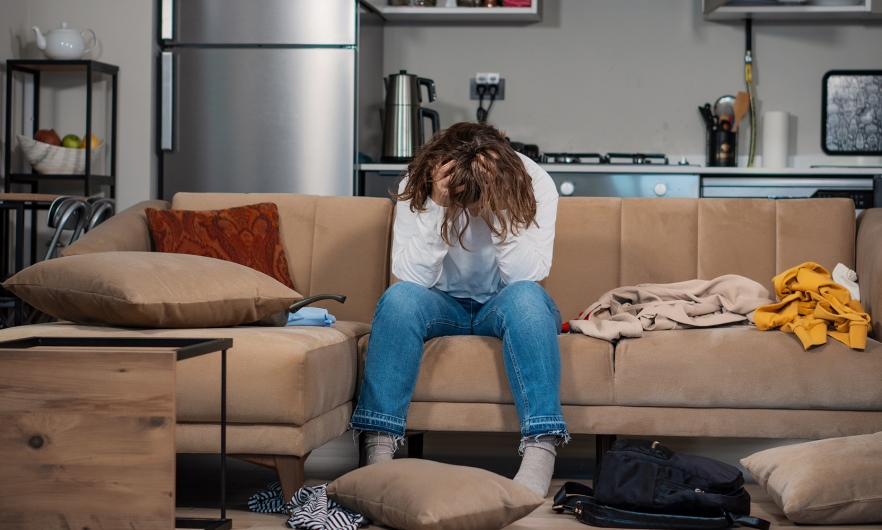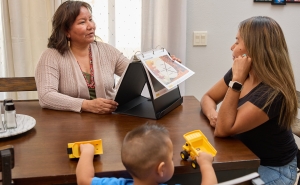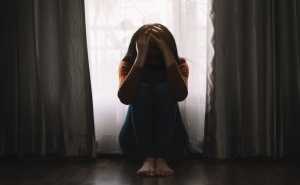PTSD Can Affect Anyone, But There Are Ways to Manage It
By increasing our understanding of PTSD, we can reduce stigma and get help to those who need it.

When people think about post-traumatic stress disorder, they often picture combat veterans or members of the military. While PTSD is highly prevalent among that group, it can affect anyone following a traumatic event or experience.
It’s estimated that in any given year, about 5% of the U.S. population has PTSD, but researchers like Tiara Willie, PhD, MA, an assistant professor of Mental Health, say that number is likely an undercount. “We anticipate the percentage is higher, for folks who are not being diagnosed with PTSD but definitely have it,” Willie says. “Unfortunately, mental health is still stigmatized in our society, so folks are not talking about it.”
She hopes that by increasing awareness of and talking more openly about mental health and the ways PTSD can manifest, people will be able to more easily identify the symptoms in themselves or a loved one and feel more comfortable seeking or offering support. “Given the multiple sources of trauma that occur in our lives … it’s important to know if someone close to you is silently suffering due to PTSD,” Willie says.
What causes PTSD?
While not everyone who experiences a traumatic event will develop PTSD, any traumatic event can cause it. Sexual assault, childhood abuse, mass violence, immigration, accident or injury, and death of a loved one are just some experiences that can result in PTSD.
The correlation between intimate partner violence and PTSD and depression has been well-documented by experts like Jacquelyn Campbell, PhD, a professor in Health Policy and Management and pioneer in the field of domestic and intimate partner violence.
PTSD has been increasingly recognized as an outcome of natural disasters, which are commonplace in many parts of the world but have happened somewhat infrequently in the U.S. “With Hurricane Katrina, we [in the U.S.] started to have real conversations about PTSD as an aftermath of these natural disasters that are affecting us,” Willie says.
What are the symptoms of PTSD?
Symptoms of PTSD vary in type and severity from one person to the next. They are typically broken down into four clusters:
- Reexperiencing, particularly through intrusive thoughts like flashbacks, memories, and dreams.
- Avoidance of physical or emotional reminders of a traumatic experience.
- Negative cognitions and mood, including distorted beliefs about oneself, diminished interest in activities, disconnect from others, and inability to remember key aspects of a traumatic event.
- Arousal, which can take the form of irritability, hypervigilance, sleep disturbances, aggression, and reckless or self-destructive behavior.
How is PTSD treated?
While there is no cure for PTSD, the symptoms can be managed to the point that they no longer impact a person’s daily function. Trauma-focused psychotherapies are considered the most effective method for addressing PTSD, Willie says. Some medications can help reduce PTSD symptoms, which individuals can discuss with their doctor.
In addition, Willie emphasizes positive coping actions—things like support groups and therapy, relaxation methods, exercise, and distraction through activities. The National Center for PTSD offers a detailed list of positive coping actions, including ways to deal with specific symptoms like distressing memories, panic attacks, anger, and sleep disruptions.
Can PTSD be prevented?
The only way to entirely prevent PTSD is to prevent trauma. That’s where public health research and policies come in: to reduce the prevalence of issues like gun violence, pandemics, intimate partner violence, injury, and more, so that fewer people experience the traumas that can lead to PTSD.
For those who do experience PTSD symptoms following trauma, research is ongoing to determine if and how early treatment interventions may help reduce their severity.
How can I support someone who has PTSD?
“The importance of small gestures is often overlooked,” Willie says. “Being present, not victim-blaming, offering a listening ear, and asking the person, ‘what do you need?’ before trying to do things for them.”
She also mentions the role people can play in remembering a friend or family member’s “trauma anniversary” and offering a positive distraction during a time when they are more likely to be reminded of the traumatic event they experienced. Willie suggests that scheduling activities or time together with a person with PTSD can help keep their spirits up and may reduce the chance they will fall back on maladaptive coping behaviors.
What can I do if I think I’m experiencing PTSD?
The first step is to find a therapist or psychologist to talk to about your symptoms. “It’s a really hard step,” Willie admits, but it’s an essential one in order to receive a diagnosis. A diagnosis of PTSD allows a person to access therapies to help with their specific symptoms.
Where can I learn more about PTSD?
You can find additional information and resources related to PTSD, symptoms, and treatment at the following links:
- National Center for PTSD
- National Child Traumatic Stress Network
- AboutFace (for military veterans)
Aliza Rosen is a digital content strategist in the Office of External Affairs at the Johns Hopkins Bloomberg School of Public Health.
RELATED:
- Invisible Wounds (Magazine, 2015)
- Study Suggests Drug Overdose Linked to PTSD
- The Science of Mindfulness (podcast)





